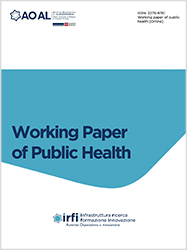Analysis of geographical distribution of high-grade glioma diagnoses in the Alessandria province: pilot study preliminary results
Accepted: 8 July 2024
All claims expressed in this article are solely those of the authors and do not necessarily represent those of their affiliated organizations, or those of the publisher, the editors and the reviewers. Any product that may be evaluated in this article or claim that may be made by its manufacturer is not guaranteed or endorsed by the publisher.
Background: one under-researched line of investigation is gliomas, which are a group of malignant brain tumours with highly poor prognoses. Despite efforts to identify environmental risk factors for gliomas, their etiology still remains unclear. It turns out that several future developments are needed in order to understand other potential risk factors. To this end, the primary objective of the present pilot study is to conduct an assessment of the spatial distribution of high-grade brain tumor cases in the province of Alessandria, where possible risk factors such as the presence of chemical industries and asbestiform fibers are found.
Materials and Methods: the study sample consisted of all patients diagnosed with high-grade glioma between January 2018 and April 2023, residents in the province of Alessandria at the time of diagnosis and referred to the health facilities of the "Azienda Sanitaria Locale di Alessandria" and the "Azienda Universitario-Ospedaliera di Alessandria". Biographical and pathological history variables were collected, and finally, data were processed in aggregate and anonymized form. A total of 103 deceased patients were enrolled, stratified by age and type of diagnosis.
Results: it was seen that the city with the most cases was Alessandria, with 27 diagnoses found during the period under review (26.2%), followed by cities of Acqui Terme, Casale Monferrato, and Novi Ligure with seven diagnoses (6.8%). Preliminary results presented in this paper were compared with data already published.
Conclusions: analyses performed to arrive at an initial geographical distribution of high-grade glioma diagnoses are consistent relative to the population density of each municipality considered.
Thompson G, A-Lawrie T, Ashleigh K, et al. Interval brain imaging for adults with cerebral glioma. Cochrane Database Syst Rev 2019;2019:CD013137. DOI: https://doi.org/10.1002/14651858.CD013137.pub2
Villani V, Casini B, Tanzilli A, et al. The Glioma-IRE project – Molecular profiling in patients with glioma: steps toward an individualized diagnostic and therapeutic approach. Journal of Translational Medicine 2023;21:215. DOI: https://doi.org/10.1186/s12967-023-04057-y
Howell AE, Robinson JW, Wootton RE, et al. Testing for causality between systematically identified risk factors and glioma: a Mendelian randomization study. BMC Cancer 2020;20:508. DOI: https://doi.org/10.1186/s12885-020-06967-2
Wang Y, Yi S, Tang J, et al. Does diabetes decrease the risk of glioma? A systematic review and meta-analysis of observational studies. Annals of Epidemiology 2019;30:22-29.e3. DOI: https://doi.org/10.1016/j.annepidem.2018.11.010
Louis DN, Perry A, Wesseling P, et al. The 2021 WHO Classification of tumors of the Central Nervous System: a summary. Neuro-Oncology 2021;29:1231-51. DOI: https://doi.org/10.1093/neuonc/noab106
Sharma A, Graber JJ. Overview of prognostic factors in adult gliomas. Annals of Palliative Medicine 2021;10:863-74. DOI: https://doi.org/10.21037/apm-20-640
Mirimanoff RO. High-grade gliomas: reality and hopes. Chinese Journal of Cancer 2014;33:1-3. DOI: https://doi.org/10.5732/cjc.013.10215
Zumel-Marne A, Castano-Vinyals G, Kundi M, et al. Environmental factors and the risk of brain tumours in young people: a systematic review. Neuroepidemiology 2019;53:121-41. DOI: https://doi.org/10.1159/000500601
Ruder AM, Waters MA, Carreòn T, et al. The Upper Midwest Health Study: a case-control study of primary intracranial gliomas in farm and rural residents. J Agric Saf Health 2006;12:255-74. DOI: https://doi.org/10.13031/2013.22013
Vienne-Jumeau A, Tafani C, Ricard D. Environmental risk factors of primary brain tumors: a review. Revue Neurologique 2019;175: 664-78. DOI: https://doi.org/10.1016/j.neurol.2019.08.004
Omuro A, DeAngelis LM. Glioblastoma and other malignant gliomas. Clinical Review & Education. JAMA 2013;310:1842-50. DOI: https://doi.org/10.1001/jama.2013.280319
Benke G, Turner MC, Fleming S, et al. Occupational solvent exposure and risk of glioma in the INTEROCC Study. British Journal of Cancer 2017;117:1246-54. DOI: https://doi.org/10.1038/bjc.2017.285
Istituto Superiore di Sanità (ISS). Available from: https://www.isssalute.it/
Istituto Nazionale di Statistica (ISTAT). Resident population as of 1st January 2023: Piedmont. Available from: https:/www.dati.istat.it/
Hartmann C, Hentschel B, Wick W, et al. Patients with IDH1 wild type anaplastic atrocytomas exhibit worse prognosis than IDH1-mutated glioblastomas, and IDH1 mutation status accounts for the unfavorable prognostic effect of higher age: implication for classification of gliomas. Acta Neuropathol 2010;120:707-18. DOI: https://doi.org/10.1007/s00401-010-0781-z
Millward CP, Brodbelt AR, Haylock B, et al. The impact of MGMT methylation and IDH1 mutation on long-term outcome for glioblastoma treated with chemoradiotherapy. Acta Neurochir 2016;158:1943-53. DOI: https://doi.org/10.1007/s00701-016-2928-8
Copyright (c) 2024 Marianna Farotto, Marinella Bertolotti, Antonella Cassinari, Roberta Libener, Carolina Pelazza, Marta Betti, Antonio Maconi

This work is licensed under a Creative Commons Attribution-NonCommercial 4.0 International License.
PAGEPress has chosen to apply the Creative Commons Attribution NonCommercial 4.0 International License (CC BY-NC 4.0) to all manuscripts to be published.

 https://doi.org/10.4081/wpph.2024.9918
https://doi.org/10.4081/wpph.2024.9918




